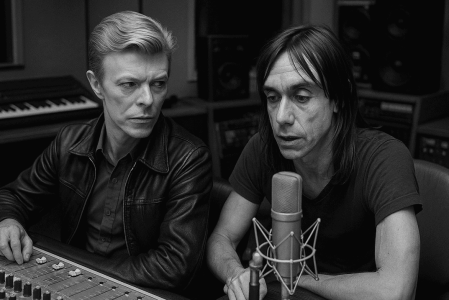When David Bowie met Iggy Pop in the early 1970s, both artists were at a crossroads. Bowie was riding high after the success of Ziggy Stardust, but struggling with fame and drug use. Iggy Pop, once the wild frontman of The Stooges, was nearly forgotten—burnt out and without a band. Their paths crossed at just the right time. Bowie saw something vital in Iggy’s raw energy, and Iggy saw a chance to rebuild with Bowie’s help.
We explore how their creative and personal bond changed the course of rock music. Their work together not only revived Iggy’s career but also pushed Bowie into bold new sounds. Together, they shaped a gritty, emotional, and lasting legacy that still influences artists today.
Origins of the Partnership
David Bowie and Iggy Pop first connected in the mid-1970s, during a time of crisis for both. Bowie was deep into cocaine addiction and felt lost in the chaos of fame. Iggy, once the face of The Stooges, was dealing with mental health issues and a stalled career. Despite their troubles, they admired each other’s work. Bowie respected Iggy’s fearless stage presence and raw style. Iggy saw Bowie as a master of reinvention with a deep sense of artistry.
They shared a love for bold, challenging music. Both were inspired by early rock ‘n’ roll, American rhythm and blues, and the growing scene in Europe. They also connected over a desire to escape the excess of the music industry and find something more honest. This mix of respect, struggle, and vision became the foundation of their creative bond.
The Berlin Years
In 1976, Bowie and Iggy Pop moved to West Berlin. They needed a break—from drugs, fame, and the toxic scenes they left behind in Los Angeles. Berlin offered anonymity and a chance to start over. It was a divided city, scarred by history but alive with underground culture and artistic energy. That tension fit them both.
Bowie rented an apartment with Iggy and acted as a mentor and collaborator. They kept a low profile, focusing on health, routine, and making music. The city’s cold, industrial atmosphere influenced their sound—darker, more experimental, stripped of glam. They soaked in local music like krautrock, especially bands like Neu! and Kraftwerk. That influence ran through their Berlin-era records: raw synths, stark rhythms, and introspective lyrics. Berlin didn’t just change where they lived—it changed how they created.
Collaborative Works
The Berlin period produced some of the most vital work in both artists’ careers. Bowie took the lead in helping Iggy Pop relaunch his solo path. In 1977, they released The Idiot and Lust for Life—albums that marked Iggy’s rebirth. Bowie co-wrote and produced both records, playing keyboards and shaping the sound. The Idiot leaned into cold, electronic textures, while Lust for Life had a sharper, more rock-driven edge. Songs like “Nightclubbing” and “The Passenger” still stand as post-punk landmarks.
At the same time, Iggy influenced Bowie’s own work. Low and Heroes, two parts of Bowie’s famed Berlin Trilogy, show that cross-pollination. Iggy’s rawness pushed Bowie into deeper, more emotional territory. Bowie wrote with him, but also absorbed Iggy’s directness and edge. The roles blurred—Bowie the producer, Iggy the muse, both feeding off each other’s energy. Their partnership wasn’t about ego. It was about pushing limits, together.
Musical Innovations and Aesthetic Impact
The sound Bowie and Iggy built together was sharp, minimal, and ahead of its time. It blended the aggression of punk with the cold precision of krautrock and the moodiness of art rock. The result was a stark contrast to the polished mainstream of the late ’70s.
The Idiot introduced heavy use of synthesizers, mechanical rhythms, and spoken-style vocals—mood over melody. “Nightclubbing,” with its drum machine pulse and eerie atmosphere, felt like a blueprint for industrial and goth. Lust for Life balanced that with raw energy—driving drums, biting guitars, and more live-band feel. Tracks like “The Passenger” and “Lust for Life” showed how primal force and clever songwriting could co-exist.
These records—and Bowie’s Low and Heroes—laid the groundwork for post-punk, new wave, and electronic rock. Bands like Joy Division, Depeche Mode, and Nine Inch Nails owe a clear debt. They didn’t just influence a sound. They helped define an attitude: emotionally detached, sonically bold, and unconcerned with commercial polish.
Personal Dynamics
At the heart of their collaboration was a deep, mutual respect. Bowie and Iggy Pop weren’t just musical partners—they were friends who pulled each other out of darkness. Bowie helped Iggy check into a psychiatric hospital when things hit bottom. Later, Iggy returned the support, keeping Bowie grounded during his recovery from addiction.
Their friendship was built on trust. Bowie gave Iggy the space and tools to reclaim his voice. In turn, Iggy’s raw honesty challenged Bowie to strip away artifice and dig deeper. They lived together, worked side by side, and leaned on each other when few others understood them.
That closeness came through in the music. There’s a sense of shared purpose—of two artists rebuilding themselves through sound. The records feel intimate, even when they’re cold or abstract. That tension—between control and chaos, distance and closeness—is what made their collaboration so real, and so powerful.
Closing Thoughts
The collaboration between David Bowie and Iggy Pop stands as one of rock’s most meaningful partnerships. It wasn’t built on commercial goals or image—it was built on survival, creativity, and trust. Together, they redefined what it meant to start over, turning personal crisis into lasting innovation.
Their work showed that collaboration can be more than just shared credit. It can be a lifeline. Today, in an industry driven by fast trends and surface-level features, their story is a reminder of what real artistic partnership looks like: honest, risky, and deeply human.
